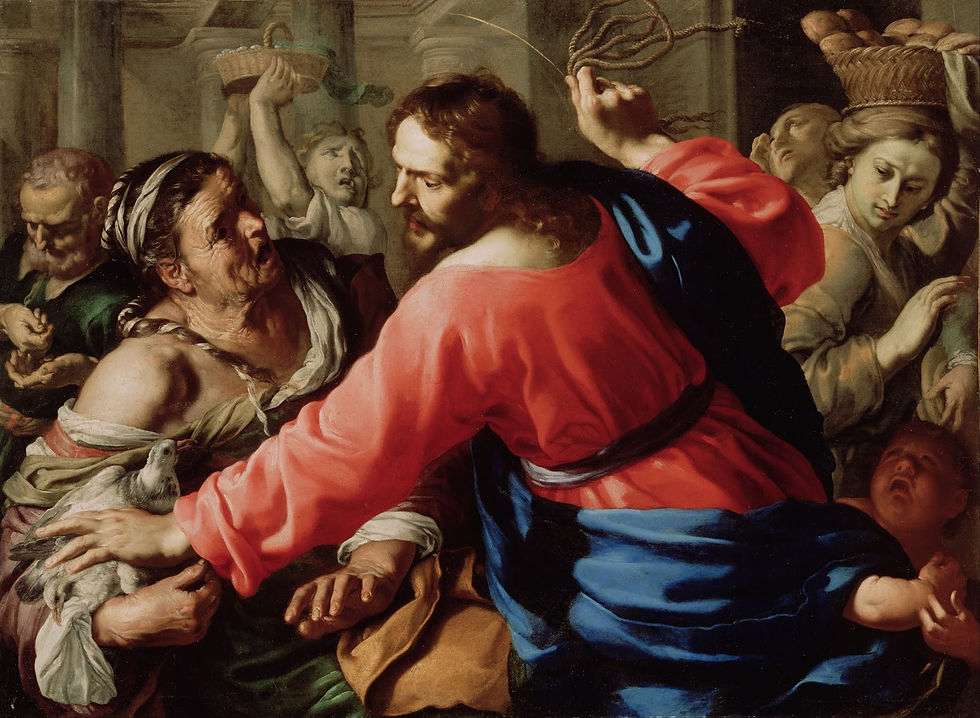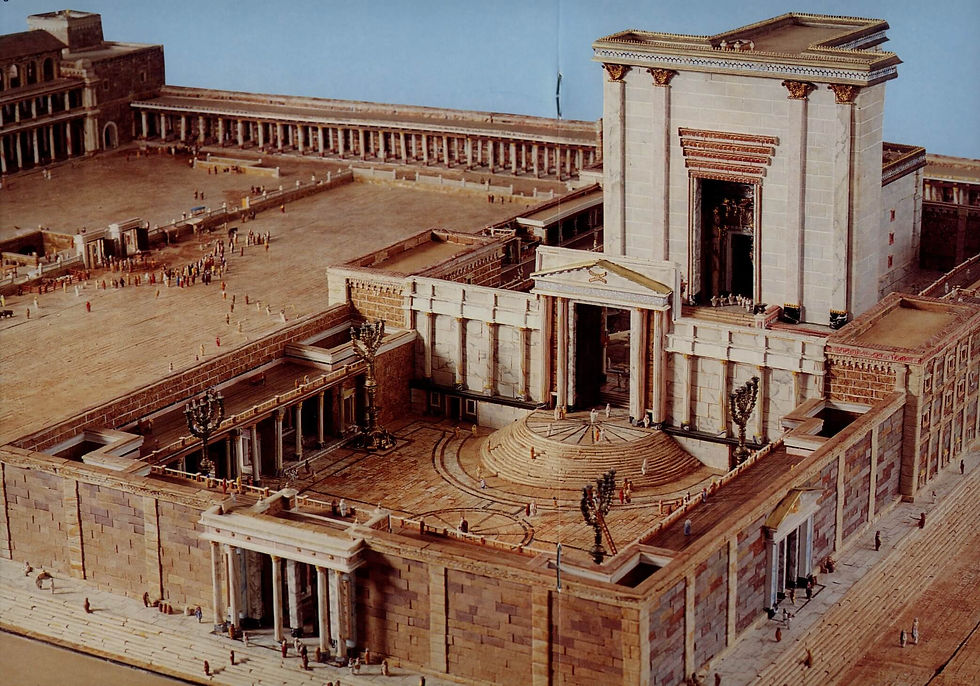Sunday School Overview: Sacred Altars and Holy Gifts
- Feature

- Jun 27
- 6 min read
By: Rev. Adrian Grubbs
Unit 2: Jesus and the Temple
The four lessons in July are about times that Jesus had contact with, and words about, the temple.
The temple compound in Jesus’ day was approximately 390 yards by 320 yards, enclosed in a wall that was almost square. The inner-side of the wall was lined with porticos where groups could assemble. That is where rabbis taught their students, especially during festivals, and where Jesus met with His disciples during Holy Week. Another wall inside the Court of Gentiles enclosed the temple itself, the altar, the court of Israel, and the court of women. Most references to the temple in the Gospels was to the temple compound, since only priests entered the temple proper, and only the high priest entered the Holy of Holies and approached the ark of the covenant on the Day of Atonement.

In Luke 2, note that it was the custom of Mary and Joseph to make the pilgrimage to Jerusalem for the Jewish festivals. At the age of twelve Jesus went with them to Jerusalem for Passover, since a boy became a man at that age. It was also customary for pilgrims to travel with a larger group – it was safer and more fun. When it came time for the group to start back to Galilee, unbeknownst to anyone, Jesus stayed behind. Apparently, he had gone to one of the temple porticos to hear the rabbis teach. That is where Mary and Joseph found their son “after three days” (Have we heard other references to “three days”?). They did not find him teaching the rabbis, rather, he was listening and asking amazing questions. Mary reprimanded him for causing his “father” and her such anxiety. He responded by asking if she did not realize that he had to be in his “Father’s” house. Anyway, he returned with them, was obedient to them, continued with his learning, and was found to be favorable to God and to people. Jesus was not born with divine knowledge and power; he set that aside when he was born into a human family (Philippians 2:7).
In Matthew 12 the temple was nowhere near, but Jesus challenged the Pharisaic sense of the sacredness of the sabbath, and he made a comment about the temple. The Pharisees saw Jesus’ disciples plucking heads of wheat and eating the grain on the sabbath. Don’t they know better? Hasn’t Jesus taught them better? In reply Jesus associated his disciples and himself with David and his warriors as he recalled the time when they were hungry and ate the holy bread from a sacred shrine (the temple had not been built). He also pointed out that priests violate the sabbath in the performance of their duties. They were shocked when Jesus declared that he and his disciples were more important than the temple (12:6). He aggravated their anger more when he claimed to be Lord of the sabbath! He was not saying that it is okay to forget the rules and regulations and do what feels right, but he suggested that they consider mercy above sacrifice (Hosea 6:6).

In John 2, just prior to Passover, Jesus went to the temple and became very disturbed by what he saw; merchants had turned the Lord’s House into a marketplace! Of course, they were providing a valuable service by offering sacrificial animals for sale to pilgrims who had come to worship. Jesus was so angered that he used a whip to drive out the merchants and the animals; and he overturned the tables of those exchanging currency, scattering coins everywhere. The temple officials asked for a sign to prove he had authority to do as he did. Jesus spoke of himself as a temple of God and said when they destroy it (kill him) he would be raised in “three days” (there it is again, “three days”). They did not get it.
It is a challenge to interpret Matthew 24-25. The church culture I grew up in read this text as pertaining to the Second Coming, so that is how I understood it; and there are possibly some hints in that direction, but the text is about more. Matthew 24:2 always raised a question in my mind; in that verse Jesus clearly predicted the destruction of the temple, so how did the second coming get into it? Let me suggest that you take five minutes to read Matthew 24-25 from a different perspective. Lay aside thoughts of the Second Coming for a moment and read it with the disciples’ questions in mind. When Jesus told them that the temple would be demolished, they had three questions: 1) When would the temple fall? 2) What would be the sign of Jesus’ “parousia”? 3) What would be the sign of “the end of the age?”
First, it is quite clear that Jesus told them that the temple would collapse – the temple would be demolished – the stones with which the temple was built would be “thrown down.” Jesus often spoke on two levels; e.g., His parables were simple, real-life stories but with deeper, spiritual implications for those who were ready to hear. That is also true of Matthew 24-25. Jesus was saying, not only that the temple building would be destroyed, but the temple-cult would be demolished as well. The temple had become the glory and pride of Israel; the temple had become all important in the minds of the people and priests but in the eyes of God had become totally corrupt. So, the Lord would abandon the temple, leaving it exposed to the whims of a foreign power, as He did in 586 BC for Babylon (Ezekiel 11:22) He did for Rome in AD 70. (Actually, the Lord abandoned the temple when Jesus died on the cross and the temple curtain was ripped apart; then He was raised on the third day, and on the fiftieth day the Lord entered His new temple in Acts 2; about forty years later the Jewish temple was destroyed and has never been rebuilt). Jesus did not give them the date, but He cautioned them to carefully read the signs correctly, because false prophets and saviors (messiahs) will mislead many.

The disciples’ second question was about the parousia – that is the Greek word many people think only means the Second Coming. Literally, the word means “appearing, presence, or coming.” Jesus often told his disciples, and those he had healed, to tell no one that he was the Christ. The disciples wanted to know when He would reveal Himself, when He would present Himself to the world as the Messiah. There may be undertones about the Second Coming, such as, nobody knew when the Romans would attack Jerusalem and nobody knows when Christ will return; and beware of false saviors who promise quick and easy answers to the Roman problem and of those who predict the end of the world.
Thirdly, the disciples wanted a sign for the end of the age. Some English translations say “the end of the world,” but the Greek word has the sense of an age, or an era, or a stage of development. Jesus’ preached and taught that he was bringing the Kingdom of God near to all people. His coming into the human world was bringing an end to one age and the beginning to another. His birth, life, death, resurrection, and ascension was a period of transition from the former times to “these last days” (Hebrews 1:1-2). Jesus’ death and resurrection was the sign for the end of one age and the beginning of another. Again, Jesus cautioned about misreading the signs, such as the reference to Daniel. The Book of Daniel is an apocalypse written around 165 BC and must be read as such; the “abomination of desolation” in Daniel referred to the ruler of Syria, Antiochus IV, who placed an image of Zeus in the Jerusalem temple and sacrificed a pig on the altar. Before Jerusalem and the temple were demolished in AD 70 the Romans attempted to do something similar. Jesus’ advice to his followers was to flee when they saw the storm clouds gathering and before the Romans surrounded the city (their standards carried images of eagles – Jesus called them vultures).
Dare we put our faith in politicians, guns, and armies instead of the Lord our God?




Comments